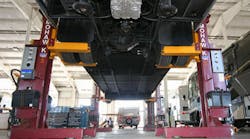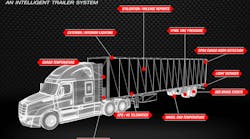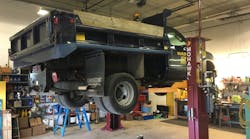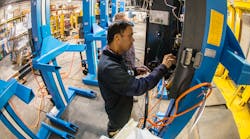A vehicle lift can be one of the most productivity-enhancing pieces of equipment in a fleet maintenance facility. It can also be one of the most dangerous – if the wrong type of lift is being used, or technicians are not using it properly.
There are several styles of lifts to choose from. Regardless of which style is purchased, several leading manufacturers agree that the ALI Gold Label is an essential feature to look for.
ALI is the Automotive Lift Institute. According to its president, R.W. “Bob” O’Gorman, one of the most important considerations from a safety perspective is whether or not the lift has been third-party tested and certified by ALI to meet the requirements of North America’s applicable electrical and mechanical safety standards. The ANSI/ALI ALCTV (current edition) Standard for Automotive Lifts, “Safety Requirements for Construction, Testing and Validation,” is the primary standard that applies.
“ALI recommends never buying an uncertified lift,” O’Gorman says. “After all, your safety is riding on it. Plus, in most of the U.S. and Canada, local building codes require that only certified lifts be installed. The International Building Code, which is in use or adopted by all 50 U.S. states, requires that all installed vehicle lifts conform with ANSI/ALI ALCTV.”
Steve Perlstein, president of Mohawk Lifts, says it is important to note that lift accessories, including high-reach jack stands, must also be certified as an accessory to the lift model. That certification is in accordance with ANSI/ASME PASE.
“Roughly 60 percent of people who purchase a mobile column lift also purchase a set of mobile jack stands,” Perlstein points out. “If a fleet is using high-reach jack stands that [are] not certified, the fleet has just voided the certification of the lift itself.” Mohawk is a manufacturer of above-ground vehicle lifts and lifting accessories.
It is also important to note that ALI certification is a completely voluntary program. While many lifts from many leading manufacturers seek and attain the ALI Gold Label, not all do. Looking for that ALI stamp of approval is an important step in a fleet’s lift-buying research.
What type of lift do you need?
Paul Feldman, director of marketing for Stertil-Koni, says another important research step is to identify the parameters, requirements and limitations of the maintenance facility. For example, fleets should consider total square footage and ceiling height, as well as how level the floor is because lifts have varying limitations. Stertil-Koni is a manufacturer of heavy duty lifting equipment.
Mohawk’s Perlstein says fleets should also think about operating conditions. Are there temperature limitations for operation? Can the lift be used outside? How long does it take to raise a vehicle, and how long must a technician wait between cycles? Will that wait time negatively impact a technician’s efficiency?
Fleets should also think about the services being performed. Do technicians need access to the tires? How many vehicles will be lifted over the course of a day and how heavy are those vehicles?
“There are many types of heavy duty vehicle lifts,” says Peter Bowers, technical sales support manager at Stertil-Koni. Arguably the most popular in a fleet setting is the mobile column lift. According to Bowers, a big reason why fleets like this style of lift is that they don’t own the maintenance facility they operate in. A mobile column lift just sits on top of a concrete slab, making it a non-permanent part of the building, not to mention portable.
Allister Collings, president of SLEC Inc., says fleets buy mobile lifts for two reasons. One is the portability factor. The other is under-vehicle access. “The lift can be wheeled around the shop and used in any work bay—even outside should the need arise,” Collings says. “Then, accessibility is unobstructed because all lifting devices are under the tire, leaving everything else free.” SLEC is a manufacturer of mobile column lifts.
When it comes to mobile column lifts, Mohawk’s Perlstein says column construction is important. What is it made out of, and how strong and durable is it? Additionally, fleets should take a close look at baseplate size and construction, as well as the mobile column lift unit’s wheels. “These types of features help ensure that a lift is well-grounded and stabilized, and also safer and easier to move,” Perlstein explains. “Rubber-coated wheels roll over a shop floor’s expansion seams and cracks much easier.”
Once a user has decided to purchase a mobile column lift, Collings says there are two decisions that will guide the fleet in a particular direction, provided that cost isn’t the overriding factor. “Fleets can choose hydraulic versus steel screw and bronze load nut, and wired versus wireless,” Collings says, adding that one isn’t necessarily better than the other. “A hydraulic lift is faster to raise and lower [approximately 94 seconds] which will appeal to some fleets. The self-locking screw lift is a bit more robust, but will operate slower [approximately 150 seconds] for peace of mind. If the fleet is typically lifting two vehicles per day, the time saved is four minutes – no big deal.”
Wireless operation can be appealing to fleets because there are no cords to deal with, which also reduces a tripping hazard in the shop. However, as Perlstein points out, fleets should remain cognizant of potential drawbacks to wireless operation, such as potential intermittent signal interruptions.
Perlstein also says fleets shouldn’t be so quick to dismiss cycle time. Some manufacturers offer hydraulic lifts with rise times in the 60- to 66-second range. A fleet must also acknowledge the fact that it takes that same amount of time to lower a vehicle. Additionally, Perlstein says a lift is typically used three or four times a day.
Considering all of that, Perlstein says the difference between a 90-second lift and a 60-second lift can really add up over the course of a year. A 60-second lift executed four times a day can equate to roughly 34-2/3 hours of waiting for the technician. A 90-second lift can equate to roughly 52 hours.
The mobile column lift isn’t the only lift type fleets can benefit from. Other types include platform, swing-arm wheel-engaging two-post and inground lifts in both low-depth scissor style and traditional vertical piston. “Fleets need to think about what they are lifting, the weight of the vehicles they are lifting, any weight imbalance from front to rear and the services their technicians will be providing while a vehicle is lifted,” Stertil-Koni’s Feldman says.
As an example, Feldman says a fleet needing to perform quick oil changes can benefit from a lift they can drive a vehicle on and off of easily. A platform lift could be a good choice. “A platform lift is also good for checking things like chassis and brakes for DOT inspections,” Stertil-Koni’s Bowers adds.
Fleets may also want wheels-free lifting to work on tires. Feldman says an in-ground piston lift or scissor lift can be a good choice because they engage the vehicle frame. For all of these reasons and more, Feldman says many fleet facilities have more than one style of lift. It all depends on the unique needs of a given fleet.
Lift manufacturers also offer various accessories to help fleets expand the capabilities and productivity of their lifts. Mohawk, for instance, offers an adapter that allows fleets to convert a two-post lift to a drive-on lift. Also, adapters are available that facilitate drive-on functionality, but allow wheels to hang free for easier service and total undercarriage access.
Tips to ensure safe and proper lifting
According to Mohawk’s Perlstein, overloading the swing arms is one of the biggest mistakes a fleet technician can make. Take the two-post lift, for example. Every two-post lift has four swing arms. Each swing arm has its own capacity. For instance, an 18,000-lb lift divided by four swing arms means each swing arm can handle 4,500 lbs. If a technician is needing to lift a 16,000-lb vehicle, that technician might think that all is well. However, if the vehicle is rear-heavy, the technician must ensure that those rear swing arms aren’t being overloaded.
Some lifts come with a vehicle weight gauge that helps technicians know how much total weight they are lifting. Still, a technician needs to understand how a given vehicle’s weight is distributed.
Another thing to think about, Perlstein adds, is how the vehicle is being lifted. This is particularly important with dually trucks. “A truck engineer designs a certain truck to travel down the road on four rear tires,” Perlstein relates. “That is to spread the load due to the weight being carried by the truck. If the truck is designed to go down the road on four rear tires, shouldn’t it be lifted by all four rear tires? If a technician tries to lift the vehicle just by its outside rear tires, that over-pressurizes the outside tires.”
In other words, fork length can be an important lift consideration for fleets. Some manufacturers, including Mohawk, offer 22” lifting forks which raise both dual tires. Adjustable forks can also prove beneficial for a fleet that is servicing a variety of vehicles. Adjustable forks do not need wheel reducer sleeves, making it easier and more convenient for the technician. “Also, some wheel reducer sleeves do not have locks on them, which can be a safety concern,” Perlstein adds.
Similarly, front-to-rear adapters can allow fleets to lift with only two columns. The important thing to think about is how much capacity is certified in the two-column configuration. “Before you go out and spend all this money on a lift, make sure it is right for your application,” Perlstein says.
Built-in safety locking mechanisms are another important lift feature fleets should scrutinize. For instance, most of Stertil-Koni’s hydraulic lifts have a mechanical locking system. “If something were to happen to the hydraulics, while rare, the lift will literally lock in place and become a stand,” Feldman points out. “When you listen to our lifts go up, you can hear the locks engaging. It’s the sound of steel on steel, and all of our customers talk about that sound. To us, it’s the prettiest sound there is because it’s the sound of safety. Mechanical locks also make an enormous difference in terms of the comfort level of a technician.”
Another sound best practice is to implement safeguards to ensure that only authorized technicians can operate a lift. Stertil-Koni has built-in safeguards where users need a key fob to activate a lift.
Speaking of technicians, proper and continual training is paramount. “Sometimes technicians get into a groove and want to move a little bit quicker,” Stertil-Koni’s Bowers says. “It’s important to fight that temptation to cut corners.” For example, Feldman says a good best practice is to raise a vehicle about 12” and then pause to conduct a walkaround and ensure that everything is stable.
“Every technician in the shop should be trained on the proper operation of each lift they will use,” ALI’s O’Gorman says. “This lift-specific training should be based on the lift manufacturer-provided instructions and warning labels, as well as the ALI publications, ‘Quick Reference Guide, Vehicle Lifting Points for Frame-Engaging Lifts, Safety Tips’ and the ANSI/ALI ALOIM [current edition] Standard for Automotive Lifts, ‘Safety Requirements for Operation, Inspection and Maintenance.’”
For general lift safety training, ALI has developed an online interactive training course entitled “Lifting It Right.” This course can be completed on a computer or mobile device in about an hour, in English or Spanish.
For an easy shop reminder of basic lift safety tips, ALI also offers an updated and expanded Automotive Lift Safety Tips Card and new Safety Tips Poster. Both feature 13 tips for safe lifting, including lift operation, maintenance and inspection.
Maintenance and cost of ownership
A heavy duty vehicle lift can be a significant investment. Given how much is at stake – the protection of both technicians and the vehicles they are servicing – fleets should resist the urge to bargain shop.
Stertil-Koni’s Bowers says fleets should be aware of what can happen when buying online from an outlet like Amazon. “A lift is a long-term investment, so it’s important to make sure a strong vendor support structure will be there for you,” he says. Distributor-provided training can be of assistance, especially for fleets that suffer technician turnover.
Mohawk’s Perlstein says fleets should also understand not only what it costs to purchase a lift, but what it costs to operate and maintain it. “Rarely is the cheapest machine to own also the cheapest to buy,” Perlstein says. “What is the warranty on the structural components? How about the moving parts? Fleets need to think about all of that along with maintenance needs, associated bay downtime if something malfunctions and what that all will cost the fleet.”
SLEC’s Collings says fleets should also evaluate the vendor’s parts inventory, along with its ability to provide after-hours service support. “Here at SLEC, we advocate a customer visit on any lift on at least an annual basis,” Collings relates.
With strong vendor support and maintenance practices, Collings says a quality lift should last a long time. “We regularly see columns coming into our shop on trade-in that are in excess of 20 years old,” he says.
To maximize lift longevity, thorough annual inspections can be very beneficial. ALI can play a pivotal role here. In fact, annual lift inspections are required by ANSI (ANSI/ALI ALOIM current edition). ALI has offered its Lift Inspection Certification Program since 2012. As a result, there are certified inspectors all over the country who can come in and inspect a fleet’s lift(s) to help maintain compliance, not to mention peace of mind that the lift is continuing to function safely and efficiently.
The easiest way to make sure you hire a qualified lift inspector, ALI’s O’Gorman says, is to choose an ALI Certified Lift Inspector. “These individuals have been tested and found qualified to inspect any vehicle lift, regardless of age, origin or manufacturer. A searchable online directory of ALI Certified Lift Inspectors is available on our website,” O’Gorman says.
Beyond annual inspections, it’s important for fleets to keep their lifts clean. Stertil-Koni’s Bowers offers a word of advice.
“Pressure washing can help in some ways, but that’s really the lazy man’s way of cleaning,” Bowers says. “You need to be careful that water doesn’t get in any areas it shouldn’t, such as the electrical control panel on some of today’s lifts. Some areas are okay to pressure wash, such as the platform on a platform lift. A big part of a mobile column lift is also okay, but again, watch out for the control box. When it comes to cleaning a lift, there really is no substitute for a little elbow grease.”
Aside from keeping a lift clean, Stertil-Koni’s Feldman says there is little else a fleet has to do. Hydraulic fluid should be monitored and changed every couple of years. There are basic grease points to keep an eye on as outlined in the manufacturer’s maintenance manual. When fleets make a commitment to keeping their lifts clean and regularly inspected, and their technicians continually trained, a long life of safe and efficient lifting can be achieved.







